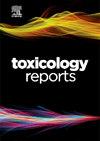Equations for estimating binary mixture toxicity: Methyl-2-chloroacetoacetate-containing combinations
Q1 Environmental Science
引用次数: 0
Abstract
Mixture toxicity was determined for 30 A+B combinations. Chemical A was the reactive soft electrophile methyl-2-chloroacetoacetate (M2CA), and chemical B was one of 30 reactive or non-reactive agents. Bioluminescence inhibition in Allovibrio fischeri was measured after 15-, 30-, and 45-minutes of exposure for A, B, and the mixture (MX) with ECx (i.e., EC25, EC50, and EC75) values being calculated. Concentration-response curves (CRCs) were developed for A and B at each exposure duration and used to create predicted CRCs for the concentration addition (CA) and independent action (IA) mixture toxicity models. Likewise, MX CRCs were generated and compared with model predictions, along with the calculation of additivity quotient (AQ) and independence quotient (IQ) values. Mixture toxicity vs. the models showed various combined effects, including toxicity that was slightly greater than IA and/or CA, consistency with CA, IA or both models, effects that were less toxic than expected for either model and antagonism. Simple linear regression analyses of time-dependent toxicity (TDT) data showed very strong correlations (r2 ≥ 0.997) for B-TDT vs. the average TDT for A and B. Likewise, for both CA and IA, multiple linear regression analyses showed strong correlations (r2 > 0.960) between MX ECx and either CA ECx and AQx or IA ECx and IQx values at each exposure duration. The results show that analyses of binary mixture toxicity data produced linear relationships resulting in equations that can effectively predict such toxicity.
估计二元混合物毒性的方程式:含甲基-2-氯乙酸酯的混合物
测定了30种 A+B组合的混合毒性。化学试剂A为反应性软亲电试剂甲基-2-氯乙酸酯(M2CA),化学试剂B为30种反应性或非反应性试剂之一。在A、B暴露15分钟、30分钟和45分钟后,测量对费氏异弧菌的生物发光抑制作用,并计算与ECx(即EC25、EC50和EC75)的混合物(MX)的值。绘制了A和B在每个暴露时间下的浓度-响应曲线(crc),并用于创建浓度添加(CA)和独立作用(IA)混合毒性模型的预测crc。同样,生成MX crc并与模型预测进行比较,同时计算可加性商(AQ)和独立商(IQ)值。混合毒性与模型相比显示出各种综合效应,包括毒性略高于IA和/或CA,与CA, IA或两者模型一致,毒性低于任何模型和拮抗的预期效果。时间依赖性毒性(TDT)数据的简单线性回归分析显示,B-TDT与A和b的平均TDT具有很强的相关性(r2≥0.997)。同样,对于CA和IA,多元线性回归分析显示出很强的相关性(r2 >;0.960), MX ECx值与CA ECx值和AQx值或IA ECx值和IQx值在每个暴露持续时间之间。结果表明,二元混合物毒性数据的分析产生了线性关系,从而可以有效地预测这种毒性。
本文章由计算机程序翻译,如有差异,请以英文原文为准。
求助全文
约1分钟内获得全文
求助全文
来源期刊

Toxicology Reports
Environmental Science-Health, Toxicology and Mutagenesis
CiteScore
7.60
自引率
0.00%
发文量
228
审稿时长
11 weeks
 求助内容:
求助内容: 应助结果提醒方式:
应助结果提醒方式:


